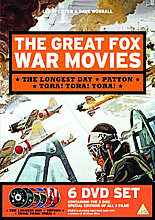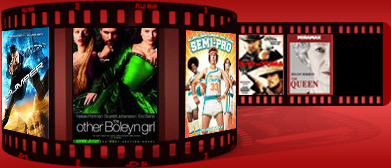
 This set contains three great war films, The Longest Day, Patton and Tora! Tora! Tora!
This set contains three great war films, The Longest Day, Patton and Tora! Tora! Tora!
The Longest Day is Hollywood's definitive D-day movie. More modern accounts such as
Saving Private Ryan are more vividly realistic, but producer Darryl F Zanuck's epic 1962 account is the only one to attempt the daunting task of covering that fateful day from all perspectives. From the German high command and front-line officers to the French Resistance and all the key Allied participants, the screenplay by Cornelius Ryan, based on his own authoritative book, is as factually accurate as possible. The endless parade of stars (John Wayne, Henry Fonda, Robert Mitchum, Sean Connery, and Richard Burton, to name a few) makes for an uneasy mix of verisimilitude and Hollywood star-power, however, and the film falls a little flat for too much of its three-hour running time. But the set-piece battles are still spectacular, and if the landings on Omaha Beach lack the graphic gore of
Private Ryan they nonetheless show the sheer scale and audacity of the invasion.
--Mark WalkerPatton - One of the greatest screen biographies ever produced,
Patton is a monumental film that won seven Academy Awards and gave George C Scott the greatest role of his career. It was released in 1970 when protest against the Vietnam War still raged in the States and abroad. Inevitably, many critics and filmgoers struggled to reconcile the events of the day with the film's glorification of US General George S Patton as a crazy-brave genius of World War II; how could a film so huge in scope and so fascinated by its subject be considered an anti-war film? The simple truth is that it's not--
Patton is less about World War II than about the rise and fall of a man whose life was literally defined by war and who felt lost and lonely without the grand-scale pursuit of an enemy. George C Scott embodies his role so fully, so convincingly, that we can't help but be drawn to and fascinated by Patton as a man who is simultaneously bound for hell and glory. The film's opening monologue alone is a masterful display of acting and character analysis and everything that follows is sheer brilliance on the part of Scott and director Franklin J Schaffner, aided in no small part by composer Jerry Goldsmith's masterfully understated score.
Filmed on an epic scale at literally dozens of European locations,
Patton does not embrace war as a noble pursuit, nor does it deny the reality of war as a breeding ground for heroes. Through the awesome achievement of Scott's performance and the film's grand ambition, General Patton shows all the complexities of a man who accepted his role in life and (like Scott) played it to the hilt.
--Jeff Shannon, Amazon.comTora! Tora! Tora! Here is just one of the many mishaps chronicled in
Tora! Tora! Tora!: "Sir, there's a large formation of planes coming in from the north, 140 miles, 3 degrees east." "Yeah? Don't worry about it." The epic film shows the bombing of Pearl Harbour from both sides in the historic first American-Japanese coproduction: American director Richard Fleischer oversaw the complicated production (the Japanese sequences were directed by Toshio Masuda and Kinji Fukasaku, after Akira Kurosawa withdrew from the film), wrestling a sprawling story with dozens of characters into a manageable, fairly easy-to-follow film. The first half maps out the collapse of diplomacy between the nations and the military blunders that left naval and air forces sitting ducks for the impending attack, while the second half is an amazing re-creation of the devastating battle. While
Tora! Tora! Tora! lacks the strong central characters that anchor the best war films, the real star of the film is the climactic 30-minute battle, a massive feat of cinematic engineering that expertly conveys the surprise, the chaos and the immense destruction. The special effects won a well-deserved Oscar, but the film was shut out of every other category by, ironically, the other epic war picture of the year,
Patton.
--Sean Axmaker, Amazon.com
 Stars: John Wayne, Richard Burton, Henry Fonda, Sean Connery, George C. Scott, Karl Malden, Stephen Young, Martin Balsam, Joseph Cotten, Tatsuya Mihashi, Koreya Senda
Stars: John Wayne, Richard Burton, Henry Fonda, Sean Connery, George C. Scott, Karl Malden, Stephen Young, Martin Balsam, Joseph Cotten, Tatsuya Mihashi, Koreya Senda

 This set contains three great war films, The Longest Day, Patton and Tora! Tora! Tora!
This set contains three great war films, The Longest Day, Patton and Tora! Tora! Tora!






















